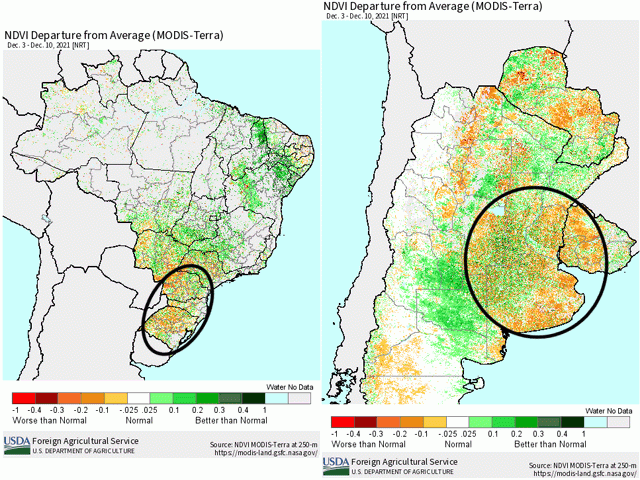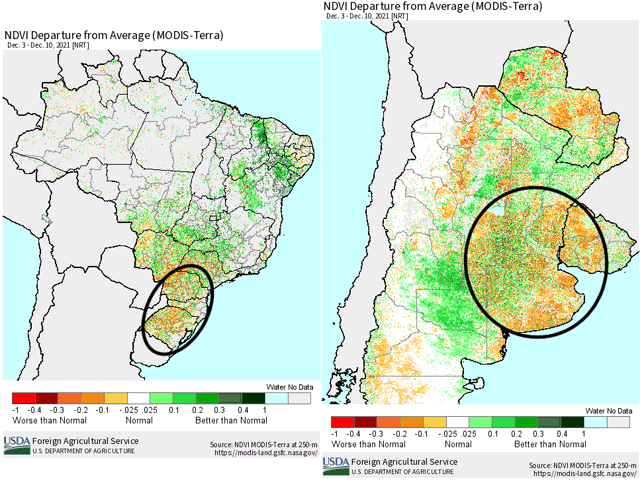South America Calling
Crop Health Declining for Portions of Argentina and Southern Brazil
La Nina continues to have an impact across southern Brazil and Argentina. Showers have been fewer with lower amounts than we typically see during the spring and early summer, though there have been exceptions to the rule in that regard.
But we are starting to see a real impact on crop health. Reports on crop conditions from governments in these areas have trended downward in recent weeks, a sign that the dryness is starting to have an impact for these early-planted crops that are going through their reproductive stages in southern Brazil and nearing or entering them in Argentina.
A look at satellite data from the USDA Foreign Agricultural Service points to declining crop conditions for large areas of Argentina and southern Brazil's growing regions. Normalized Difference Vegetation Index (NDVI) can be used as an approximation of overall crop health respective to a "normal" year. NDVI calculates the difference between near-infrared and red light. Near-infrared is light that vegetation strongly reflects, while red light is light that vegetation actively absorbs. By measuring the difference and then comparing that to average values, we can come up with an idea of how the crop is doing relative to that average. Or put more simply, how well is the crop doing compared to average.
P[L1] D[0x0] M[300x250] OOP[F] ADUNIT[] T[]
On the attached graphic, areas in green are doing better than average, or in good health, and those in orange and red are worse than average, or poor health. Circled are our areas of concern where precipitation has been lower than normal. We can see a lot more shading of oranges and reds in these areas, indicating poor crop health.
Of course, that is not the case for the entire area. Some areas within these regions are doing well while others are doing more poorly. Some of that could be attributed to planting time and rate. Southern Brazil got out to a very quick start planting soybeans and first-crop corn. These regions would be expected to be greener in the image as leaf area should be larger compared to normal and would be absorbing more light, which could anomalously indicate better health in the crop than actually exists.
In Argentina, the opposite may be true. With dryness during the spring, planting of corn and soybeans has been much slower than normal. Roughly 40% of the corn crop has been planted and has only picked up above 30% in the last couple of weeks after some good rains in November. With much of the crop behind normal, there is less leaf area to absorb light and could produce more oranges and reds, indicating poor crop health, when the crop is actually doing quite well.
The southern Brazil states of Rio Grande do Sul and Parana account for roughly 30% of the soybean crop and 25% of the corn crop, a large portion of the country's production. If conditions there are worse than we can see on satellite, there is a possibility we could see a pullback in the forecasted production of the country. However, conditions in central and northern Brazil continue to be excellent and may overcome the poor conditions in the south.
In Argentina, the matter is not so simple. With a wide range in planting dates, and much of the crop still to be planted, there is a long way to go to start messing with the production forecasts. But the forecast is not favorable for at least the next six weeks. Models, DTN and other private forecasters are expecting below-normal precipitation through this time, which would put a strain on the crop no matter when it is planted.
John Baranick can be reached at john.baranick@dtn.cdtn.com
(c) Copyright 2021 DTN, LLC. All rights reserved.






Comments
To comment, please Log In or Join our Community .